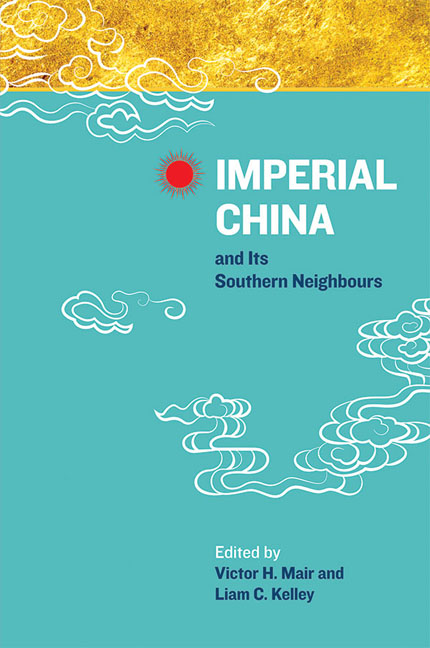Book contents
- Frontmatter
- Contents
- Preface
- The Contributors
- 1 Introduction: Imperial China Looking South
- 2 Layers of Meaning: Hairstyle and Yue Identity in Ancient Chinese Texts
- 3 Sinicization and Barbarization: Ancient State Formation at the Southern Edge of Sinitic Civilization
- 4 Clothes Make the Man: Body Culture and Ethnic Boundaries on the Lingnan Frontier in the Southern Song
- 5 What Makes a Chinese God? or, What Makes a God Chinese?
- 6 Dragon Boats and Serpent Prows: Naval Warfare and the Political Culture of China's Southern Borderlands
- 7 Inventing Traditions in Fifteenth-century Vietnam
- 8 Epidemics, Trade, and Local Worship in Vietnam, Leizhou Peninsula, and Hainan Island
- 9 Southeast Asian Primary Products and their Impact on Chinese Material Culture in the Tenth to Seventeenth Centuries
- 10 New Evidence on the History of Sino'arabic Relations: A Study of Yang Liangyao's Embassy to the Abbasid Caliphate
- 11 The Peacock's Gallbladder: An Example of Tibetan Influence in Late Imperial China
- 12 Transformation of the Yunnanese Community Along the Sino–burma Border During the Nineteenth and Early Twentieth Centuries
- 13 How the North Tried to Pacify the South Through Ritual Practices: On the Origins of the Guan Suo Opera in the Nineteenth Century
- 14 Realms Within Realms of Radiance, or, can Heaven Have Two Sons? Imperial China as Primus Inter Pares among Sino–pacific Mandala Polities
- Index
- Nalanda-Sriwijaya Series
9 - Southeast Asian Primary Products and their Impact on Chinese Material Culture in the Tenth to Seventeenth Centuries
Published online by Cambridge University Press: 06 January 2018
- Frontmatter
- Contents
- Preface
- The Contributors
- 1 Introduction: Imperial China Looking South
- 2 Layers of Meaning: Hairstyle and Yue Identity in Ancient Chinese Texts
- 3 Sinicization and Barbarization: Ancient State Formation at the Southern Edge of Sinitic Civilization
- 4 Clothes Make the Man: Body Culture and Ethnic Boundaries on the Lingnan Frontier in the Southern Song
- 5 What Makes a Chinese God? or, What Makes a God Chinese?
- 6 Dragon Boats and Serpent Prows: Naval Warfare and the Political Culture of China's Southern Borderlands
- 7 Inventing Traditions in Fifteenth-century Vietnam
- 8 Epidemics, Trade, and Local Worship in Vietnam, Leizhou Peninsula, and Hainan Island
- 9 Southeast Asian Primary Products and their Impact on Chinese Material Culture in the Tenth to Seventeenth Centuries
- 10 New Evidence on the History of Sino'arabic Relations: A Study of Yang Liangyao's Embassy to the Abbasid Caliphate
- 11 The Peacock's Gallbladder: An Example of Tibetan Influence in Late Imperial China
- 12 Transformation of the Yunnanese Community Along the Sino–burma Border During the Nineteenth and Early Twentieth Centuries
- 13 How the North Tried to Pacify the South Through Ritual Practices: On the Origins of the Guan Suo Opera in the Nineteenth Century
- 14 Realms Within Realms of Radiance, or, can Heaven Have Two Sons? Imperial China as Primus Inter Pares among Sino–pacific Mandala Polities
- Index
- Nalanda-Sriwijaya Series
Summary
Introduction
The economic interaction between Southeast Asia and China is well known and fairly well documented. The basic premise is that China's possession of technological knowledge and capabilities enabled it to produce manufactured products that were often not matched outside of its economy. At the same time, its geographical predisposition and its limited flora and fauna resources caused it to look abroad for primary resources for its material needs. One of the key sources of such materials was Southeast Asia. The region was a major supplier of raw materials and natural products to China from as early as the mid-first millennium, although this role took off strongly only from the late tenth century onwards. A wide range of high and low unit-value products, including select and bulk volume items, were imported by China during the eleventh through the second millennium AD.
In considering the issue of material cultural influences between China and the societies of Southeast Asia, the basic assumptions have hitherto been one of transfer from a more sophisticated culture to a less sophisticated other. The premise is based primarily on technological know-how, artisanal or aesthetic finesses, or iconographic complexities that embody specific representations. The notion that there may have been gaps in the recipient society that were thus filled in the process of transfer, including economic and sometimes social gaps, have been argued to be the structural context within which such material cultural influences have occurred across Asia. The developments in the ceramics traditions of such Southeast Asian societies as Vietnam and Thailand in the fifteenth and sixteenth centuries, and the development of the silk industry of Vietnam, are prime examples of such arguments.
However, if we were to reimagine the flows of material cultural influences, we might gain a different perspective on the flow of the transfer processes. Material cultural construction, for instance, does not begin only at the point of manufacturing, or the value-added stage in which human knowledge application is the key ingredient, but at the stage of raw material availability and acquisition. The raw materials determine the nature of the final product, with the influence, of course, of the means by which the materials are manipulated.
- Type
- Chapter
- Information
- Imperial China and Its Southern Neighbours , pp. 214 - 238Publisher: ISEAS–Yusof Ishak InstitutePrint publication year: 2015

